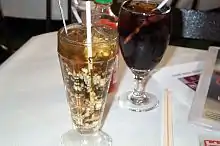Ching bo leung
Ching bo leung (Chinese: 清補涼; also spelt ching po leung or qing bu liang) is a sweet, cold soup of Chinese origin and commonly served in Cantonese cuisine, Hainanese cuisine and Guangxi cuisine. It is a type of tong sui.[1] It is known as sâm bổ lượng or chè sâm bổ lượng (chè meaning "sweet soup") in Vietnam.
 Sâm bổ lượng | |
| Alternative names | Ching po leung, qing bu liang |
|---|---|
| Type | Soup |
| Course | Lunch, dinner |
| Place of origin | China |
| Region or state | East Asia and Southeast Asia |
| Serving temperature | Cold |
| Main ingredients | Yi mai grains, dried longans, red jujubes, lotus seeds, seaweed, sugar, water, ice |
| Ching bo leung | |||||||||||
|---|---|---|---|---|---|---|---|---|---|---|---|
| Chinese name | |||||||||||
| Traditional Chinese | 清補涼 | ||||||||||
| Simplified Chinese | 清补凉 | ||||||||||
| |||||||||||
| Vietnamese name | |||||||||||
| Vietnamese | sâm bổ lượng | ||||||||||
Although the exact recipe may vary, the drink generally contains grains of yi mai (Chinese pearl barley), dried longans, red jujubes, lotus seeds, and thinly sliced seaweed, with water, sugar, and crushed ice.[2][3] In place of the yi mai, pearl barley may sometimes be used, and thinly sliced strips of ginger and/or ginseng root, wolfberries, or ginkgo nuts may also appear as ingredients.
The Chinese form of the drink, ching bo leung, is the most popular in the Cantonese cuisine of Guangdong, Hong Kong, and Macau. It is sometimes known as Luk mei soup (六味湯, lit. Six flavour soup). The Vietnamese version, sâm bổ lượng, is most readily available in Cholon, the Chinatown of Hồ Chí Minh City, and is generally served in a tall glass. Although it is sometimes described as a drink, the term "soup" is more appropriate as a spoon is generally necessary to consume the solid ingredients.
See also
References
- Young, Grace. The Wisdom of the Chinese Kitchen-Classi c Family Recipes for Celebration and He. Simon & Schuster UK Limited. p. 214. ISBN 9780684847399. Retrieved 22 March 2016.
- Young, Grace. "Healing Soups from a Chinese Kitchen: Ching Bo Leung Soup". Ogden Publications, Inc. Retrieved 22 March 2016.
- Le Gia menu "Sâm Bổ Lượng. A refreshing Vietnamese drink with logan, lotus seeds, seaweed, red dates and agar jelly. " Toptable.co.uk Archived 2013-05-05 at Archive.today